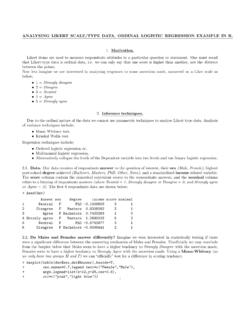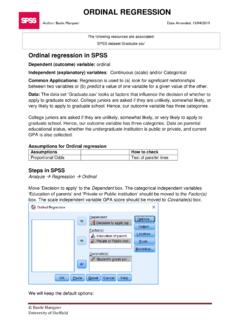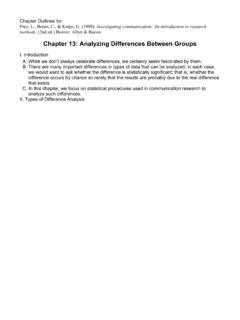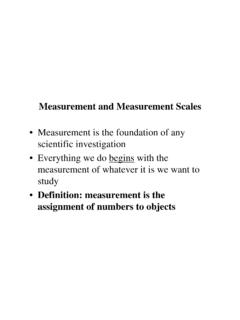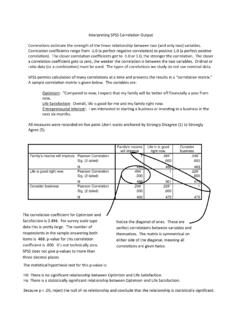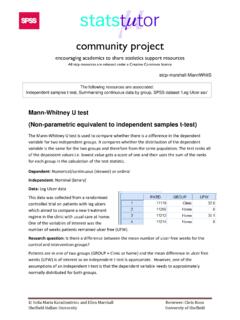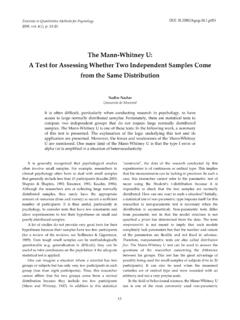Transcription of Ordinal Logistic Regression models and Statistical ...
1 Cornell Statistical Consulting UnitOrdinal Logistic Regression models and Statistical Software: What You Need to Know Statnews #91 Created June 2016. Last updated August 2020 Overview Ordinal Logistic Regression is a Statistical analysis method that can be used to model the relationship between an Ordinal response variable and one or more explanatory variables. An Ordinal variable is a categorical variable for which there is a clear ordering of the category levels. The explanatory variables may be either continuous or categorical.
2 Estimating Ordinal Logistic Regression models with Statistical software is not difficult, but the interpretation of the model output can be cumbersome. Ordinal Logistic Regression is an extension of Logistic Regression (see StatNews #81) where the logit ( the log odds) of a binary response is linearly related to the independent variables. If instead the response variable has k levels, then there are k-1 logits. A major assumption of Ordinal Logistic Regression is the assumption of proportional odds: the effect of an independent variable is constant for each increase in the level of the response.
3 Hence the output of an Ordinal Logistic Regression will contain an intercept for each level of the response except one, and a single slope for each explanatory variable. There are several ways in which an Ordinal Regression model can be parameterized and different Statistical software packages use different parameterizations. Thus, great care should be taken when interpreting the output from Ordinal Regression models . We will consider an example to illustrate the different model parameterizations and corresponding interpretation for several commonly used Statistical software packages.
4 Example dataset Suppose that customers at a bedding store are asked to rate how comfortable they find a newly engineered mattress on a scale from 1 to 3; 1 for uncomfortable, 2 for comfortable, 3 for very comfortable. The categorical explanatory variable of interest is the gender of the respondent; 0 for female, 1 for male. The simulated dataset consists of 400 total observations. Table 1 displays the number and proportion of participants within each gender responding with each of the rating categories. Table 1: Number and proportion of females and males who responded in each rating category.
5 Female (0) Male (1) Cornell Statistical Consulting Unit Female (0) Male (1) Uncomfortable (1) 28 ( ) 30 ( ) Comfortable (2) 63 ( ) 64 ( ) Very Comfortable (3) 115 ( ) 100 ( ) Parameterizations of Ordinal Logistic Regression A cumulative logit parameterization is used in Ordinal Logistic Regression models . However, there are several ways in which this can be done. Table 2 shows the common parameterizations for the cumulative logit model, where J represents the number of levels in the categorical response variable, and p represents the number of explanatory variables.
6 The most common parameterizations are models 1 and 2 where the outcome of interest is observing Y less than or equal to j where j is one of the ordered categories the response variable. For model 3, the cumulative logit parameterization specifies that the outcome of interest is observing Y greater than j . Regardless of the parameterization, the model will have J-1 cutoffs (also referred to as intercepts or threshold values), denoted by in the parameterizations below, and one parameter for each explanatory variable. This allows for the intercept to vary for each cumulative logit.
7 However, the model assumes that each explanatory variable exerts the same effect on each cumulative logit. This is why the Ordinal Logistic Regression model is also known as a proportional-odds model. Table 2: Three parameterizations of the Ordinal Logistic Regression model. Parameterization Model 1 log( ( )1 ( ))= ( 1 1+ 2 2+ + ), =1,.., 1 Model 2 log( ( )1 ( ))= + 1 1+ 2 2+ + , =1,.., 1 Model 3 log( ( > )1 ( > ))= + 1 1+ 2 2+ + , =2,.., 1, Model 1 incorporates a negative sign so that there is a direct correspondence between the slope and the ranking.
8 Thus a positive coefficient indicates that as the value of the explanatory variable increases, the likelihood of a higher ranking increases. This is also the case for the parameterization of model 3, but notice that the intercepts will differ between model 1 and model 3. Software packages for fitting Ordinal Logistic Regression Ordinal Logistic Regression models can be estimated in most Statistical software packages. Some possible implementations include: SAS: proc Logistic or proc genmod R: clm in the Ordinal package, vglm in the VGAM package, polr in the MASS package, and lrm in the rms package Stata: ologit command Cornell Statistical Consulting Unit JMP: fit model menu with the response variable classified as Ordinal SPSS.
9 Generalized linear model menu or the Ordinal Regression menu Besides knowing the parameterization of the cumulative logit implemented by a software package, a researcher must also be aware of the coding scheme and choice of reference level for categorical explanatory variables. R, Stata, SPSS, and SAS (using proc genmod) use dummy coding, while JMP and SAS (using proc Logistic ) use effect coding (see Statnews #72 for more information on these two coding schemes). Both R and Stata use the first level alphanumerically as the reference level, whereas SAS, JMP, and SPSS use the last level as the reference level.
10 However, it is possible to customize the reference level in each of these programs. Table 3: Output for models 1, 2, and 3 in different software packages. Stata, R (polr or clm) R (vglm) R (lrm) SPSS JMP or SAS (proc Logistic ) SAS (proc genmod) Model: 1 2 3 1 2 2 Coding: Dummy Dummy Dummy Dummy Effect Dummy Threshold 1, 1: Threshold 2, 2: coefficient for Gender=1 indicator na na na coefficient for Gender=0 indicator na na na Model interpretation As an example, using the Stata output we can write the functional form of the Ordinal Regression as follows.


